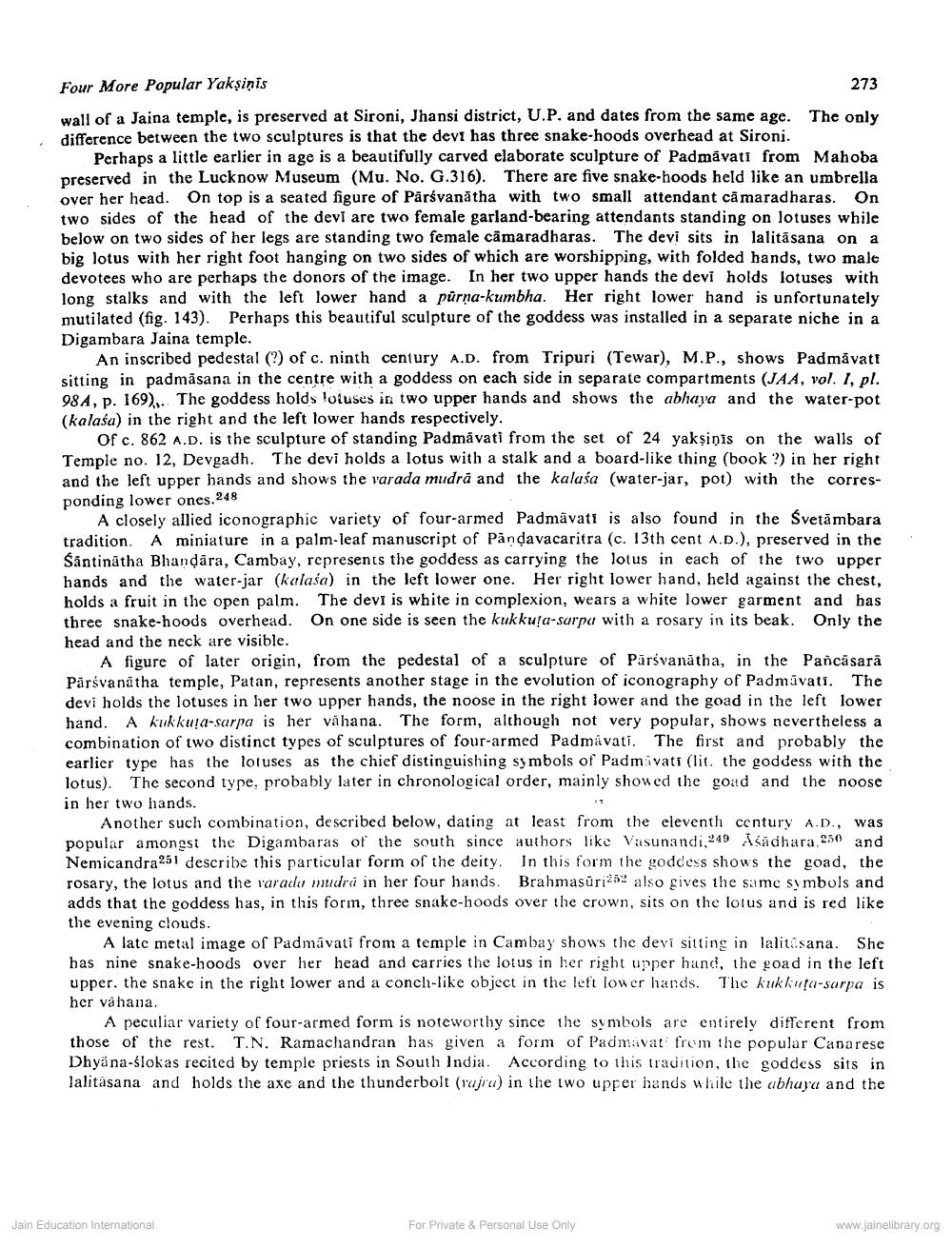________________
Four More Popular Yakṣiņis
273
wall of a Jaina temple, is preserved at Sironi, Jhansi district, U.P. and dates from the same age. The only difference between the two sculptures is that the devi has three snake-hoods overhead at Sironi.
Perhaps a little earlier in age is a beautifully carved elaborate sculpture of Padmavati from Mahoba preserved in the Lucknow Museum (Mu. No. G.316). There are five snake-hoods held like an umbrella over her head. On top is a seated figure of Pārsvanatha with two small attendant camaradharas. On two sides of the head of the devi are two female garland-bearing attendants standing on lotuses while below on two sides of her legs are standing two female camaradharas. The devi sits in lalitasana on a big lotus with her right foot hanging on two sides of which are worshipping, with folded hands, two male devotees who are perhaps the donors of the image. In her two upper hands the devi holds lotuses with long stalks and with the left lower hand a purṇa-kumbha. Her right lower hand is unfortunately mutilated (fig. 143). Perhaps this beautiful sculpture of the goddess was installed in a separate niche in a Digambara Jaina temple.
An inscribed pedestal (?) of c. ninth century A.D. from Tripuri (Tewar), M.P., shows Padmavat! sitting in padmasana in the centre with a goddess on each side in separate compartments (JAA, vol. I, pl. 984, p. 169),. The goddess holds lotuses in two upper hands and shows the abhaya and the water-pot (kalasa) in the right and the left lower hands respectively.
Of c. 862 A.D. is the sculpture of standing Padmavati from the set of 24 yakṣiņis on the walls of Temple no. 12, Devgadh. The devi holds a lotus with a stalk and a board-like thing (book ?) in her right and the left upper hands and shows the varada mudra and the kalasa (water-jar, pot) with the corresponding lower ones. 248
A closely allied iconographic variety of four-armed Padmavati is also found in the Svetambara tradition. A miniature in a palm-leaf manuscript of Pandavacaritra (c. 13th cent A.D.), preserved in the Santinatha Bhandara, Cambay, represents the goddess as carrying the lotus in each of the two upper hands and the water-jar (kalasa) in the left lower one. Her right lower hand, held against the chest, holds a fruit in the open palm. The devi is white in complexion, wears a white lower garment and has three snake-hoods overhead. On one side is seen the kukkuța-sarpa with a rosary in its beak. Only the head and the neck are visible.
A figure of later origin, from the pedestal of a sculpture of Parsvanatha, in the Pañcasarā Pārsvanatha temple, Patan, represents another stage in the evolution of iconography of Padmavati. The devi holds the lotuses in her two upper hands, the noose in the right lower and the goad in the left lower hand. A kukkuta-sarpa is her vahana. The form, although not very popular, shows nevertheless a combination of two distinct types of sculptures of four-armed Padmavati. The first and probably the earlier type has the lotuses as the chief distinguishing symbols of Padmavati (lit. the goddess with the lotus). The second type, probably later in chronological order, mainly showed the goad and the noose in her two hands.
Another such combination, described below, dating at least from the eleventh century A.D., was popular amongst the Digambaras of the south since authors like Vasunandi,249 Asadhara,250 and Nemicandra251 describe this particular form of the deity. In this form the goddess shows the goad, the rosary, the lotus and the varada mudra in her four hands. Brahmasuri252 also gives the same symbols and adds that the goddess has, in this form, three snake-hoods over the crown, sits on the lotus and is red like the evening clouds.
A late metal image of Padmavati from a temple in Cambay shows the devi sitting in lalitasana. She has nine snake-hoods over her head and carries the lotus in her right upper hand, the goad in the left upper. the snake in the right lower and a conch-like object in the left lower hands. The kukkuta-sarpa is her vahana.
A peculiar variety of four-armed form is noteworthy since the symbols are entirely different from those of the rest. T.N. Ramachandran has given a form of Padmavat from the popular Canarese Dhyana-ślokas recited by temple priests in South India. According to this tradition, the goddess sits in lalitäsana and holds the axe and the thunderbolt (vajra) in the two upper hands while the abhaya and the
Jain Education International
For Private & Personal Use Only
www.jainelibrary.org




